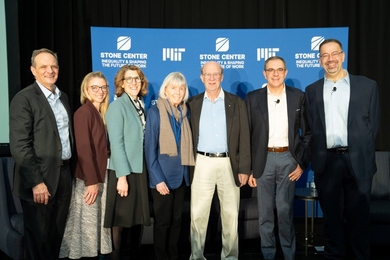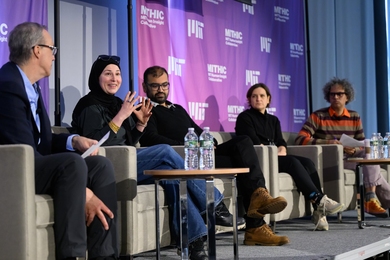MIT is home to the nation’s first academic department of architecture, founded in 1865. But the style of architecture favored at the Institute changed markedly after World War II, from a prewar emphasis on Beaux Arts buildings to a heavy focus on modernism. Now a book examines the nature of MIT-based modernism in new detail, suggesting that MIT’s emphasis on research and technology produced new directions for modernism, pushing it away from more abstract aesthetic considerations and toward more technological paradigms. Meanwhile, MIT’s campus became the site of celebrated modernist buildings by Alvar Aalto, Eero Saarinen, and I.M. Pei, among others.
Edited by Arindam Dutta, an associate professor of architectural history at MIT, the book — titled “A Second Modernism: MIT, Architecture, and the ‘Techno-Social’ Moment,” and recently published by MIT Press — collects 24 essays and first-person accounts of the successes, and struggles, of architects at MIT. Dutta calls the historical approach behind the book “not a matter of praising or criticizing institutional behavior and disciplinary trends, but of trying to build a historical account of what went on.” He recently sat down with MIT News to talk.
Q. What changed at MIT to instigate this new phase of architectural work after World War II, and who were some of the key figures in this transformation?
A. The book’s argument is that basically during the war, MIT becomes this massive research center, as opposed to simply being a kind of polytechnic, so funded research becomes a key imperative. The architects themselves are undergoing a kind of [evolution] at this point, because this is the moment that modernism is finding a home in America in a very strong way. So we find the architectural department at MIT struggling to define itself vis-à-vis other schools of architecture, but also other parts of MIT: This involves questions of … focus, discipline, curriculum, and pedagogy.
But in this ongoing struggle, with mixed results, you have a lot of great experimentation going on, and some very interesting figures: people like Pietro Belluschi, who designed the Pan Am Building [a Manhattan skyscraper, now the MetLife Building], Lawrence Anderson, Gyorgy Kepes, Kevin Lynch, N. John Habraken, John F.C. Turner. This is an exceptional group of people hired by MIT. They didn’t quite succeed in coming together as a department, but all of these people became important individually.
But what really sets MIT apart is the fact that much of the agenda within the School of Architecture and Planning is driven less by conventional goals of professional training and more by the faculty’s interest in research, particularly funded research. There is a strong interest in tying interests to agendas set by the federal government, on housing and town planning — through [the Department of Housing and Urban Development], for instance — or by foundations such as Ford and Rockefeller.
And so one key question that emerges right away is: What is research in architecture? … Is it to be discerned in technological means? Or in historical questions? How can we reconcile aesthetic questions to a “science”?
Q. What are some of the examples of the research and design going on at MIT that people may not know about, apart from some of these more famous figures?
A. Solar housing [dating to 1938] is one good example. ... Another example is the Monsanto House [an attraction at Disneyland in the 1950s and 1960s], a fascinating plastic building that’s really wild to look at. So there is a lot of that going on, but much of the research was triggered [by] support from various funders. I think it speaks to the particular constitution of MIT, which cornered by far the largest amount of federal grant monies in the postwar era. So I think MIT’s setting was unique in terms of its receptivity to these outside interventions.
In the 1960s MIT also embraced a countercultural ambience. Students and faculty were very interested in social conditions. They were heavily influenced by sociological models, but also by behaviorist models, systems theory, and so on, to the extent that some … saw conventional architecture as too aestheticized. They did not see aesthetics or formal questions as a place for the strong exploration of critical issues.
Q. When we look around campus now, what are the structures we would look to in thinking about how MIT-oriented modernist architects were applying technology to their buildings?
A. I think the Eduardo Catalano-built student center [Building W20]. That’s one of the few very visible structures designed by one of our faculty members. That would be very indicative of its time. The other example would be the house designed … by Catalano’s alter ego within the Department of Architecture, Maurice Smith, in Harvard, Mass. MIT has also been interesting in terms of being a host to various critical, very important architects of the late modern movement: Alvar Aalto, Eero Saarinen — and I.M. Pei, we should keep in mind, is an alumnus.
In the book [architectural scholar Reinhold Martin] makes the point that neither Kresge Auditorium nor the chapel [by Saarinen] were direct representations of technology, but that they were about sublimating technology [to] some great humanist goal. … In that sense Saarinen delivered brilliantly. And so did Aalto.
As I see it, architecture’s job is not to literally realize technical goals. Architecture is a medium, a mediating element between what we call culture and what we call society. So it is not a question of either accepting or rejecting technology but asking the question: How is it that technology plays out in society? That is really the question the book is asking: In what ways do technologies matter?
New book, edited by MIT architectural historian, examines the evolution of modernism during its postwar heyday at the Institute.
Publication Date:
Press Contact:

Credits:
Photo: Dominick Reuter





